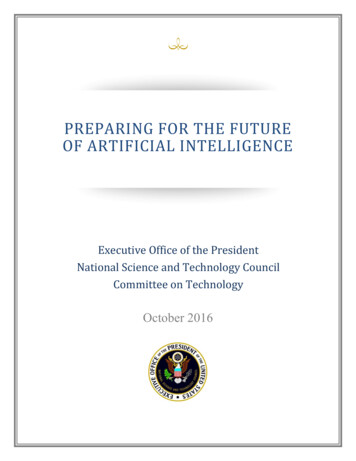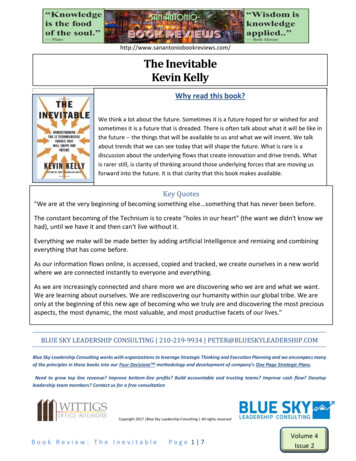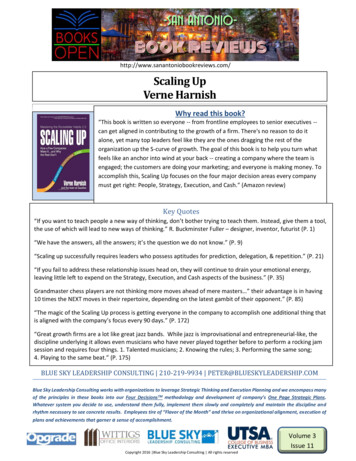
Transcription
PREPARING FOR THE FUTUREOF ARTIFICIAL INTELLIGENCEExecutive Office of the PresidentNational Science and Technology CouncilNational Science and Technology CouncilCommittee on TechnologyOctober 2016
About the National Science and Technology CouncilThe National Science and Technology Council (NSTC) is the principal means by which the ExecutiveBranch coordinates science and technology policy across the diverse entities that make up the Federalresearch and development (R&D) enterprise. One of the NSTC’s primary objectives is establishing clearnational goals for Federal science and technology investments. The NSTC prepares R&D packages aimedat accomplishing multiple national goals. The NSTC’s work is organized under five committees:Environment, Natural Resources, and Sustainability; Homeland and National Security; Science,Technology, Engineering, and Mathematics (STEM) Education; Science; and Technology. Each of thesecommittees oversees subcommittees and working groups that are focused on different aspects of scienceand technology. More information is available at www.whitehouse.gov/ostp/nstc.About the Office of Science and Technology PolicyThe Office of Science and Technology Policy (OSTP) was established by the National Science andTechnology Policy, Organization, and Priorities Act of 1976. OSTP’s responsibilities include advising thePresident in policy formulation and budget development on questions in which science and technology areimportant elements; articulating the President’s science and technology policy and programs; and fosteringstrong partnerships among Federal, state, and local governments, and the scientific communities in industryand academia. The Director of OSTP also serves as Assistant to the President for Science and Technologyand manages the NSTC. More information is available at www.whitehouse.gov/ostp.AcknowledgmentsThis document was developed through the contributions of staff from OSTP, other components of theExecutive Office of the President, and other departments and agencies. A special thanks and appreciationto everyone who contributed.Copyright InformationThis is a work of the U.S. Government and is in the public domain. It may be freely distributed, copied,and translated; acknowledgment of publication by the Office of Science and Technology Policy isappreciated. Any translation should include a disclaimer that the accuracy of the translation is theresponsibility of the translator and not OSTP. It is requested that a copy of any translation be sent toOSTP. This work is available for worldwide use and reuse and under the Creative Commons CC0 1.0Universal license.
EXECUTIVE OFFICE OF THE PRESIDENTNATIONAL SCIENCE AND TECHNOLOGY COUNCILWASHINGTON, D.C. 20502October 12, 2016Dear colleagues:Advances in Artificial Intelligence (AI) technology have opened up new markets and new opportunitiesfor progress in critical areas such as health, education, energy, and the environment. In recent years,machines have surpassed humans in the performance of certain specific tasks, such as some aspects ofimage recognition. Experts forecast that rapid progress in the field of specialized artificial intelligencewill continue. Although it is very unlikely that machines will exhibit broadly-applicable intelligencecomparable to or exceeding that of humans in the next 20 years, it is to be expected that machines willreach and exceed human performance on more and more tasks.As a contribution toward preparing the United States for a future in which AI plays a growing role, thisreport surveys the current state of AI, its existing and potential applications, and the questions that areraised for society and public policy by progress in AI. The report also makes recommendations forspecific further actions by Federal agencies and other actors. A companion document lays out a strategicplan for Federally-funded research and development in AI. Additionally, in the coming months, theAdministration will release a follow-on report exploring in greater depth the effect of AI-drivenautomation on jobs and the economy.The report was developed by the NSTC’s Subcommittee on Machine Learning and Artificial Intelligence,which was chartered in May 2016 to foster interagency coordination, to provide technical and policyadvice on topics related to AI, and to monitor the development of AI technologies across industry, theresearch community, and the Federal Government. The report was reviewed by the NSTC Committee onTechnology, which concurred with its contents. The report follows a series of public-outreach activitiesspearheaded by the White House Office of Science and Technology Policy (OSTP) in 2016, whichincluded five public workshops co-hosted with universities and other associations that are referenced inthis report.OSTP also published a Request for Information (RFI) in June 2016, which received 161 responses. Thesubmitted comments were published by OSTP on September 6, 2016. Consistent with the role of BigData as an enabler of AI, this report builds on three previous Administration reports on Big Datareferenced in this report.In the coming years, AI will continue to contribute to economic growth and will be a valuable tool forimproving the world, as long as industry, civil society, and government work together to develop thepositive aspects of the technology, manage its risks and challenges, and ensure that everyone has theopportunity to help in building an AI-enhanced society and to participate in its benefits.Sincerely,John P. HoldrenMegan SmithAssistant to the President for Science and TechnologyDirector, Office of Science and Technology PolicyU.S. Chief Technology Officer
National Science and Technology CouncilChairJohn P. HoldrenAssistant to the President for Science andTechnology and Director, Office of Science andTechnology PolicyStaffAfua BruceExecutive DirectorOffice of Science and Technology PolicySubcommittee onMachine Learning and Artificial IntelligenceCo-ChairEd FeltenDeputy U.S. Chief Technology OfficerOffice of Science and Technology PolicyExecutive SecretaryTerah LyonsPolicy Advisor to the U.S. Chief TechnologyOfficerOffice of Science and Technology PolicyCo-ChairMichael GarrisSenior ScientistNational Institute of Standards and TechnologyU.S. Department of CommerceThe following Federal departments and agencies are represented on the Subcommittee on MachineLearning and Artificial Intelligence and through it, work together to monitor the state of the art inmachine learning (ML) and AI (within the Federal Government, in the private sector, and internationally),to watch for the arrival of important technology milestones in the development of AI, to coordinate theuse of and foster the sharing of knowledge and best practices about ML and AI by the FederalGovernment, and to consult in the development of Federal research and development priorities in AI:Department of Commerce (Co-Chair)Department of DefenseDepartment of EducationDepartment of EnergyDepartment of Health and Human ServicesDepartment of Homeland SecurityDepartment of JusticeDepartment of LaborDepartment of StateDepartment of TransportationDepartment of TreasuryDepartment of Veterans AffairsUnited States Agency for InternationalDevelopmentCentral Intelligence AgencyGeneral Services AdministrationNational Science FoundationNational Security AgencyNational Aeronautics and Space AdministrationOffice of the Director of National IntelligenceSocial Security AdministrationThe following offices of the Executive Office of the President are also represented on the Subcommittee:Council of Economic AdvisersDomestic Policy CouncilOffice of Management and BudgetOffice of Science and Technology Policy (CoChair)Office of the Vice PresidentNational Economic CouncilNational Security Council
PREPARING FOR THE FUTURE OF ARTIFICIAL INTELLIGENCE
PREPARING FOR THE FUTURE OF ARTIFICIAL INTELLIGENCEContentsExecutive Summary .1Introduction .5A Brief History of AI .5What is Artificial Intelligence? .6The Current State of AI .7Public Outreach and Development of this Report . 12Applications of AI for Public Good . 13AI in the Federal Government. 15AI and Regulation . 17Case Study: Autonomous Vehicles and Aircraft .18Research and Workforce . 23Monitoring Progress in AI.23Federal Support for AI Research .25Workforce Development and Diversity .26AI, Automation, and the Economy . 29Fairness, Safety, and Governance . 30Justice, Fairness, and Accountability .30Safety and Control.32Global Considerations and Security . 35International Cooperation .35AI and Cybersecurity .36AI in Weapon Systems .37Conclusion . 39Recommendations in this Report . 40Acronyms. 43References . 45
PREPARING FOR THE FUTURE OF ARTIFICIAL INTELLIGENCE
PREPARING FOR THE FUTURE OF ARTIFICIAL INTELLIGENCEExecutive SummaryAs a contribution toward preparing the United States for a future in which Artificial Intelligence (AI)plays a growing role, we survey the current state of AI, its existing and potential applications, and thequestions that are raised for society and public policy by progress in AI. We also make recommendationsfor specific further actions by Federal agencies and other actors. A companion document called theNational Artificial Intelligence Research and Development Strategic Plan lays out a strategic plan forFederally-funded research and development in AI.Applications of AI for Public GoodOne area of great optimism about AI and machine learning is their potential to improve people’s lives byhelping to solve some of the world’s greatest challenges and inefficiencies. Many have compared thepromise of AI to the transformative impacts of advancements in mobile computing. Public- and privatesector investments in basic and applied R&D on AI have already begun reaping major benefits to thepublic in fields as diverse as health care, transportation, the environment, criminal justice, and economicinclusion. The effectiveness of government itself is being increased as agencies build their capacity to useAI to carry out their missions more quickly, responsively, and efficiently.AI and RegulationAI has applications in many products, such as cars and aircraft, which are subject to regulation designedto protect the public from harm and ensure fairness in economic competition. How will the incorporationof AI into these products affect the relevant regulatory approaches? In general, the approach to regulationof AI-enabled products to protect public safety should be informed by assessment of the aspects of riskthat the addition of AI may reduce alongside the aspects of risk that it may increase. If a risk falls withinthe bounds of an existing regulatory regime, moreover, the policy discussion should start by consideringwhether the existing regulations already adequately address the risk, or whether they need to be adaptedto the addition of AI. Also, where regulatory responses to the addition of AI threaten to increase the costof compliance, or slow the development or adoption of beneficial innovations, policymakers shouldconsider how those responses could be adjusted to lower costs and barriers to innovation withoutadversely impacting safety or market fairness.Currently relevant examples of the regulatory challenges that AI-enabled products present are found inthe cases of automated vehicles (AVs, such as self-driving cars) and AI-equipped unmanned aircraftsystems (UAS, or “drones”). In the long run, AVs will likely save many lives by reducing driver error andincreasing personal mobility, and UAS will offer many economic benefits. Yet public safety must beprotected as these technologies are tested and begin to mature. The Department of Transportation (DOT)is using an approach to evolving the relevant regulations that is based on building expertise in theDepartment, creating safe spaces and test beds for experimentation, and working with industry and civilsociety to evolve performance-based regulations that will enable more uses as evidence of safe operationaccumulates.Research and WorkforceGovernment also has an important role to play in the advancement of AI through research anddevelopment and the growth of a skilled, diverse workforce. A separate strategic plan for Federallyfunded AI research and development is being released in conjunction with this report. The plan discussesthe role of Federal R&D, identifies areas of opportunity, and recommends ways to coordinate R&D tomaximize benefit and build a highly-trained workforce.1
PREPARING FOR THE FUTURE OF ARTIFICIAL INTELLIGENCEGiven the strategic importance of AI, moreover, it is appropriate for the Federal Government to monitordevelopments in the field worldwide in order to get early warning of important changes arising elsewherein case these require changes in U.S. policy.The rapid growth of AI has dramatically increased the need for people with relevant skills to support andadvance the field. An AI-enabled world demands a data-literate citizenry that is able to read, use,interpret, and communicate about data, and participate in policy debates about matters affected by AI. AIknowledge and education are increasingly emphasized in Federal Science, Technology, Engineering, andMathematics (STEM) education programs. AI education is also a component of Computer Science forAll, the President’s initiative to empower all American students from kindergarten through high school tolearn computer science and be equipped with the computational thinking skills they need in a technologydriven world.Economic Impacts of AIAI’s central economic effect in the short term will be the automation of tasks that could not be automatedbefore. This will likely increase productivity and create wealth, but it may also affect particular types ofjobs in different ways, reducing demand for certain skills that can be automated while increasing demandfor other skills that are complementary to AI. Analysis by the White House Council of EconomicAdvisors (CEA) suggests that the negative effect of automation will be greatest on lower-wage jobs, andthat there is a risk that AI-driven automation will increase the wage gap between less-educated and moreeducated workers, potentially increasing economic inequality. Public policy can address these risks,ensuring that workers are retrained and able to succeed in occupations that are complementary to, ratherthan competing with, automation. Public policy can also ensure that the economic benefits created by AIare shared broadly, and assure that AI responsibly ushers in a new age in the global economy.Fairness, Safety, and GovernanceAs AI technologies move toward broader deployment, technical experts, policy analysts, and ethicistshave raised concerns about unintended consequences of widespread adoption. Use of AI to makeconsequential decisions about people, often replacing decisions made by human-driven bureaucraticprocesses, leads to concerns about how to ensure justice, fairness, and accountability—the same concernsvoiced previously in the Administration’s Big Data: Seizing Opportunities, Preserving Values report of2014,1 as well as the Report to the President on Big Data and Privacy: A Technological Perspectivepublished by the President’s Council of Advisors on Science and Technology in 2014.2 Transparencyconcerns focus not only on the data and algorithms involved, but also on the potential to have some formof explanation for any AI-based determination. Yet AI experts have cautioned that there are inherentchallenges in trying to understand and predict the behavior of advanced AI systems.Use of AI to control physical-world equipment leads to concerns about safety, especially as systems areexposed to the full complexity of the human environment. A major challenge in AI safety is buildingsystems that can safely transition from the “closed world” of the laboratory into the outside “open world”where unpredictable things can happen. Adapting gracefully to unforeseen situations is difficult yetnecessary for safe operation. Experience in building other types of safety-critical systems andinfrastructure, such as aircraft, power plants, bridges, and vehicles, has much to teach AI practitioners“Big Data: Seizing Opportunities, Preserving Values,” Executive Office of the President, May s/docs/big data privacy report may 1 2014.pdf.1The President’s Council of Advisors on Science and Technology, “Report to the President: Big Data and Privacy:A Technological Perspective,” Executive Office of the President, May s/microsites/ostp/PCAST/pcast big data and privacy may 2014.pdf.22
PREPARING FOR THE FUTURE OF ARTIFICIAL INTELLIGENCEabout verification and validation, how to build a safety case for a technology, how to manage risk, andhow to communicate with stakeholders about risk.At a technical level, the challenges of fairness and safety are related. In both cases, practitioners strive toavoid unintended behavior, and to generate the evidence needed to give stakeholders justified confidencethat unintended failures are unlikely.Ethical training for AI practitioners and students is a necessary part of the solution. Ideally, every studentlearning AI, computer science, or data science would be exposed to curriculum and discussion on relatedethics and security topics. However, ethics alone is not sufficient. Ethics can help practitioners understandtheir responsibilities to all stakeholders, but ethical training should be augmented with technical tools andmethods for putting good intentions into practice by doing the technical work needed to preventunacceptable outcomes.Global Considerations and SecurityAI poses policy questions across a range of areas in international relations and security. AI has been atopic of interest in recent international discussions as countries, multilateral institutions, and otherstakeholders have begun to access the benefits and challenges of AI. Dialogue and cooperation betweenthese entities could help advance AI R&D and harness AI for good, while also addressing sharedchallenges.Today’s AI has important applications in cybersecurity, and is expected to play an increasing role for bothdefensive and offensive cyber measures. Currently, designing and operating secure systems requiressignificant time and attention from experts. Automating this expert work partially or entirely may increasesecurity across a much broader range of systems and applications at dramatically lower cost, and couldincrease the agility of the Nation’s cyber-defenses. Using AI may help maintain the rapid responserequired to detect and react to the landscape of evolving threats.Challenging issues are raised by the potential use of AI in weapon systems. The United States hasincorporated autonomy in certain weapon systems for decades, allowing for greater precision in the use ofweapons and safer, more humane military operations. Nonetheless, moving away from direct humancontrol of weapon systems involves some risks and can raise legal and ethical questions.The key to incorporating autonomous and semi-autonomous weapon systems into American defenseplanning is to ensure that U.S. Government entities are always acting in accordance with internationalhumanitarian law, taking appropriate steps to control proliferation, and working with partners and Alliesto develop standards related to the development and use of such weapon systems. The United States hasactively participated in ongoing international discussion on Lethal Autonomous Weapon Systems, andanticipates continued robust international discussion of these potential weapon systems. Agencies acrossthe U.S. Government are working to develop a single, government-wide policy, consistent withinternational humanitarian law, on autonomous and semi-autonomous weapons.Preparing for the FutureAI holds the potential to be a major driver of economic growth and social progress, if industry, civilsociety, government, and the public work together to support development of the technology withthoughtful attention to its potential and to managing its risks.The U.S. Government has several roles to play. It can convene conversations about important issues andhelp to set the agenda for public debate. It can monitor the safety and fairness of applications as theydevelop, and adapt regulatory frameworks to encourage innovation while protecting the public. It canprovide public policy tools to ensure that disruption in the means and methods of work enabled by AIincreases productivity while avoiding negative economic consequences for certain sectors of theworkforce. It can support basic research and the application of AI to public good. It can supportdevelopment of a skilled, diverse workforce. And government can use AI itself to serve the public faster,3
PREPARING FOR THE FUTURE OF ARTIFICIAL INTELLIGENCEmore effectively, and at lower cost. Many areas of public policy, from education and the economic safetynet, to defense, environmental preservation, and criminal justice, will see new opportunities and newchallenges driven by the continued progress of AI. The U.S. Government must continue to build itscapacity to understand and adapt to these changes.As the technology of AI continues to develop, practitioners must ensure that AI-enabled systems aregovernable; that they are open, transparent, and understandable; that they can work effectively withpeople; and that their operation will remain consistent with human values and aspirations. Researchersand practitioners have increased their attention to these challenges, and should continue to focus on them.Developing and studying machine intelligence can help us better understand and appreciate our humanintelligence. Used thoughtfully, AI can augment our intelligence, helping us chart a better and wiser pathforward.A full list of the recommendations made in this report is on page 40.4
PREPARING FOR THE FUTURE OF ARTIFICIAL INTELLIGENCEIntroductionArtificial Intelligence (AI) has the potential to help address some of the biggest challenges that societyfaces. Smart vehicles may save hundreds of thousands of lives every year worldwide, and increasemobility for the elderly and those with disabilities. Smart buildings may save energy and reduce carbonemissions. Precision medicine may extend life and increase quality of life. Smarter government may servecitizens more quickly and precisely, better protect those at risk, and save money. AI-enhanced educationmay help teachers give every child an education that opens doors to a secure and fulfilling life. These arejust a few of the potential benefits if the technology is developed with an eye to its benefits and withcareful consideration of its risks and challenges.The United States has been at the forefront of foundational research in AI, primarily supported for most ofthe field’s history by Federal research funding and work at government laboratories. The FederalGovernment’s support for unclassified AI R&D is managed through the Networking and InformationTechnology Research and Development (NITRD) program, and supported primarily by the DefenseAdvanced Research Projects Agency (DARPA), the National Science Foundation (NSF), the NationalInstitutes of Health (NIH), the Office of Naval Research (ONR), and the Intelligence Advanced ResearchProjects Activity (IARPA). Major national research efforts such as the National Strategic ComputingInitiative, the Big Data Initiative, and the Brain Research through Advancing InnovativeNeurotechnologies (BRAIN) Initiative also contribute indirectly to the progress of AI research. Thecurrent and projected benefits of AI technology are large, adding to the Nation’s economic vitality and tothe productivity and well-being of its people. A companion document lays out a strategic plan forFederally-funded research and development in AI.As a contribution toward preparing the United States for a future in which AI plays a growing role, wesurvey the current state of AI, its existing and potential applications, and the questions that progress in AIraise for society and public policy. We also make recommendations for specific further actions by Federalagencies and other actors.A Brief History of AIEndowing computers with human-like intelligence has been a dream of computer experts since the dawnof electronic computing. Although the term “Artificial Intelligence” was not coined until 1956, the rootsof the field go back to at least the 1940s,3 and the idea of AI was crystalized in Alan Turing’s famous1950 paper, “Computing Machinery and Intelligence.” Turing’s paper posed the question: “Can machinesthink?” It also proposed a test for answering that question,4 and raised the possibility that a machine mightbe programmed to learn from experience much as a young child does.In the ensuing decades, the field of AI went through ups and downs as some AI research problems provedmore difficult than anticipated and others proved insurmountable with the technologies of the time. Itwasn’t until the late 1990s that research progress in AI began to accelerate, as researchers focused moreon sub-problems of AI and the application of AI to real-world problems such as image recognition andmedical diagnosis. An early milestone was the 1997 victory of IBM’s chess-playing computer Deep BlueSee, e.g., Warren S. McCulloch and Walter H. Pitts, “A Logical Calculus of the Ideas Immanent in NervousActivity,” Bulletin of Mathematical Biophysics, 5:115-133, 1943.3Restated in modern terms, the “Turing Test” puts a human judge in a text-based chat room with either anotherperson or a computer. The human judge can interrogate the other party and carry on a conversation, and then thejudge is asked to guess whether the other party is a person or a computer. If a computer can consistently fool humanjudges in this game, then the computer is deemed to be exhibiting intelligence.45
PREPARING FOR THE FUTURE OF ARTIFICIAL INTELLIGENCEover world champion Garry Kasparov. Other significant breakthroughs included DARPA’s CognitiveAgent that Learns and Organizes (CALO), which led to Apple Inc.’s Siri; IBM’s question-answeringcomputer Watson’s victory in the TV game show “Jeopardy!”; and the surprising success of self-drivingcars in the DARPA Grand Challenge competitions in the 2000s.The current wave of progress and enthusiasm for AI began around 2010, driven by three factors that builtupon each other: the availability of big data from sources including e-commerce, businesses, socialmedia, science, and government; which pro
Learning and Artificial Intelligence and through it, work together to monitor the state of the art in machine learning (ML) and AI (within the Federal Government, in the private sector, and internationally), to watch for the arrival of important technology milestones in











